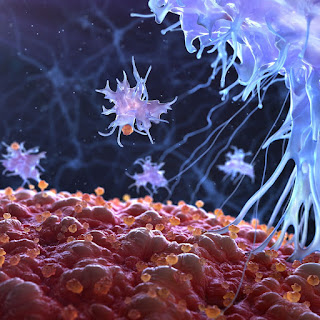We often picture inflammation as a storm of cytokines — TNF-α, IL-6, interferons — released by immune cells. But inflammation is more than chemistry: it reshapes mechanics at the cellular and tissue level resulting in stiffening blood vessels, increasing vascular tone, and causing edema. Inflammation forces tissues into stretch and strain (Pober & Sessa, 2007: ; Schiffrin, 2014:).
Cells sense this stretch as stress. Endothelial and smooth muscle cells don’t simply absorb it — they activate protective and inflammatory pathways. At the crossroads of this response is p53, the well-known “guardian of the genome,” which here becomes a translator of mechanical stress into immune tone.
Inflammation Creates Stretch
At the onset of inflammation, immune cells like neutrophils and macrophages release cytokines (TNF-α, IL-1β, IL-6) and reactive oxygen species. These trigger several physical consequences:
-
Vasoconstriction: cytokines reduce nitric oxide and increase endothelin-1, raising intravascular pressure (Virdis & Schiffrin, 2003:).
-
Edema: increased vascular permeability leads to tissue swelling, compressing vessels from the outside (Ley et al., 2007:).
-
Stiffening: macrophages and T cells drive fibrosis through collagen deposition and TGF-β, making vessel walls less compliant (Intengan & Schiffrin, 2000:).
Together, these changes simulate mechanical stretch at the microvascular level.
Stretch Activates p53
Mechanical strain is known to activate p53 through oxidative stress, DNA damage responses, and ER stress (Madrazo & Kelly, 2008:). In vascular cells:
-
Endothelial cells: p53 can reduce IL-6 (by competing with NF-κB) but enhance interferon signaling (via STAT1/IRF9) (Vousden & Prives, 2009:).
-
Smooth muscle cells: p53 drives cell cycle arrest and senescence, stabilizing the vessel wall but promoting stiffness (Giaccia & Kastan, 1998:).
-
Immune cells (including NK cells): p53 regulates survival, apoptosis, and cytokine output, balancing activation against exhaustion (Menendez et al., 2009:).
Thus, p53 acts as a convergence point where inflammation-induced mechanics meet immune regulation.
NK Cells: Partners in the Loop
Natural killer (NK) cells illustrate how mechanics and immunity are intertwined.
-
Early NK response (hours to day 1): NKs are rapidly recruited by cytokines and stress ligands, releasing IFN-γ and TNF-α, and injuring stressed endothelial cells. Here, p53 activity in vascular cells biases the environment toward interferon signaling, supporting NK activation (Vivier et al., 2011:).
-
Transition phase (days): macrophages and dendritic cells dominate, producing IL-6 and TNF-α. p53 in these myeloid cells restrains NF-κB–driven cytokines while promoting type I interferons, further priming NK cells (Sakaguchi et al., 2020:).
-
Late NK response (days–weeks): NKs amplify chronic inflammation through IFN-γ, TNF-α, and antibody-dependent cytotoxicity. In this phase, p53 may push NKs toward exhaustion, while senescent endothelial and smooth muscle cells release SASP factors (IL-6, IL-8) that perpetuate the cycle (Coppe et al., 2010:).
The Feedback Loop
Inflammation and stretch are not separate. They form a self-reinforcing loop:
-
Inflammation → Stretch: cytokines alter vascular tone, stiffness, and permeability.
-
Stretch → p53 activation: p53 senses the stress in endothelial, smooth muscle, and NK cells.
-
p53 → Immune tone: restrains IL-6, enhances interferons, and modulates NK cell survival and cytokine balance.
-
NK cells → More inflammation: IFN-γ and TNF-α amplify vascular injury and immune recruitment.
This cycle explains why hypertension, vascular inflammation, and immune activation are so tightly linked.
Why It Matters
Understanding how inflammation leads to mechanical stress, and how p53 links stretch to immunity, may open therapeutic opportunities:
-
Reducing vascular stiffness could break the loop between mechanics and inflammation.
-
Modulating p53 might rebalance cytokine outputs (lowering IL-6 while supporting interferons).
-
Preserving NK cell function under stress could sustain protective immunity without driving exhaustion.
🔑 Takeaway: Inflammation doesn’t just signal with cytokines — it also stretches tissues. This stretch activates p53, which reshapes the immune response, especially in NK cells. Together they form a loop where mechanics and immunity reinforce one another in health and disease.










